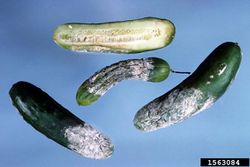Phytophthora capsici
| Literature database |
|---|
| 475 articles sorted by: |
| • year (descending) |
| • research topics |
| • countries/regions |
| • host plants |
| • list of antagonists |

Author(s): Charles Averre, North Carolina State University
Source: IPM Images
Phytophthora capsici Leonian 1922 - (root rot of pepper)
The oomycete has a world-wide distribution and causes a destructive rot and blight disease on pepper and other Solanaceae like tomatoes. It also infects Cucurbitaceae and many other crops. The pathogen can cause rots and damping off on seedlings. Severe epidemics have been reported from various regions on pepper and squash crops. On pepper, roots and stems are infected first, followed by leaves and fruits. Symptoms on other crops include leaf spots, necrosis, fruit rot and damping off. Symptoms develop within a few days after an infection and death of the plant often follows a few days later. The pathogen persist in plant debris and as thick-walled oospores. It readily disperses through irrigation or rain water, e.g. as sporangia. Management options include improved drainage, crop rotation for at least 3 years, as well as fungicides and resistant cultivars.
| Vernacular names | |
|---|---|
| • Deutsch: | Wurzelbrand der Tomate |
| • English: | root rot of pepper blight of pepper Phytophthora blight of cucurbits |
| • Español: | pudrición del pie del pimiento |
Sporangia are egg-shaped, around 20-40 µm long, 15-30 µm wide and detach easily. They can germinate directly or produce zoospores. Chlamydospores have not been observed. The species is heterothallic and requires mating types A1 and A2 to produce oospores. Oogonia are 30-35 µm in diameter with a dark pigmentation.
For details see the respective page in Wikipedia.
- Other images of Phytophthora capsici (IPM Images - click to enlarge)


